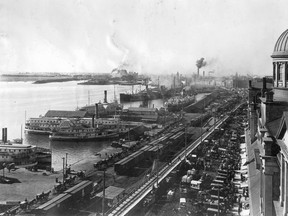From the archives: Spring thaw: New season brought celebrations - and bad news

Article content
This story was first published on April 30, 2006, in the Montreal Gazette.
The water front was the centre of attraction for Montrealers Saturday and yesterday, and hundreds of citizens found their way there to see the first of the fleet of incoming ocean steamers.
Gazette, Monday, April 30, 1906
With ships now using the port of Montreal 12 months of the year, and indeed with all the other ways we communicate today, it’s sometimes hard to grasp how isolated Montrealers could feel once winter closed in, a century ago and more. Spring truly seemed to arrive not with the first robin but with the first trans-Atlantic ship.
The first to appear in 1906 was the Marina of the Donaldson Line. She had left Glasgow on the same tide as an Allan steamer, the Ontarian, but was able to reach Montreal ahead of her when the Ontarian stopped at Quebec City. On board the Marina, in addition to general cargo, were 46 Shetland ponies, a dozen Clydesdales and nine passengers.
Capt. Taylor received a prize for being the first to dock, but it wasn’t the traditional gold-headed cane. Instead, it was a top hat. Hats were the Montreal Harbour Commission’s first prizes, starting in the 1840s, but they began giving way to canes around 1880. Why Taylor was stuck with a mere hat, like those earlier captains first to arrive, is not known.
Elsewhere that day, two firemen from the Chaboillez Square station were badly hurt when the salvage wagon they were racing to a fire piled into a streetcar at St. Paul and McGill streets. Somehow, only one horse was hurt, and at that only slightly.
It was all for nothing. The alarm was a false one, turned in by a man who spotted some smoke over a St. Paul St. building. There was smoke – coming from a chimney – but no fire.
Meanwhile, over at the old Central Fire Station on Craig St. (now St. Antoine), a shed-like structure had just been erected over the sidewalk in front to protect pedestrians from falling masonry. The building was Montreal’s original fire hall, erected in 1863, but so shoddy was its construction that it was condemned barely 20 years later.
Every inspection since had confirmed that decision, yet the structure was still in use. Chief Zephirin Benoit warned the city’s Fire Committee a few weeks earlier that it could come down on top of his men at any time, but to no avail.
Things were a little more promising for men under the roof of Montreal’s antiquated jail. During a speech to the city’s Reform Club, Jules Allard, Quebec’s public works minister, announced plans to build a new one.
Allard made it clear that this decision followed a remarkable intervention by the governor-general, Lord Grey. The previous year, Grey had complained to Premier Lomer Gouin about conditions in the jail, and followed this up with a letter to Gouin after another visit to the jail in February.
“The lot of the convict prisoner in a federal penitentiary is preferable to that of an unconvicted prisoner awaiting trial in a provincial jail,” Grey wrote to the premier a day later. The federal convict was given work to do, he said, and a cell of his own with electric light until 8:30 p.m. Provincial prisoners, by contrast, were given no work, no chance to exercise, and might be locked up as long for as four months before being tried.
Clearly, Gouin was stung by Grey’s intervention. In a letter of reply, he agreed that the state of the jail was unacceptable. Allard, at the Reform Club dinner, not only made public the correspondence between the two but added that money would be set aside for a new jail at the legislature’s next sitting.
It could scarcely be ready in time to accommodate Joseph Carrier, however. Carrier sold cash registers and was accused of absconding to New York with $273 in receipts. There, for four months, he lay low. But he happened to be “an expert stenographer.”
Prompted by their colleagues, New York police placed a help-wanted ad in the papers offering a fat salary to someone who could take dictation in French. Carrier answered the advertisement, was arrested and then handed over to face the music back here.
A 60-year-old painter, Magloire Bisson, was taken in agony to Notre Dame Hospital. He had swallowed Paris green, a toxic insecticide and pigment. He was drunk, it seems, and mistook the poison for “something else.” He died hours after being admitted.
There was happier news to greet “spring” in Montreal, however. The maple syrup for 1906 was exceptionally good. And – a sign of things to come – Montreal’s first auto show had just closed, after attracting more than 20,000 people. So certain were the organizers of the automobile’s future that plans were already being made for a second show the following year.
“When the hour of closing, 10.30, came, and the Victoria Rifles’ band had played the National Anthem,” we reported, “a perfect bedlam arose through the tooting of every horn in the building.”
It was, we said, a kind of “motor concert for Montreal.”